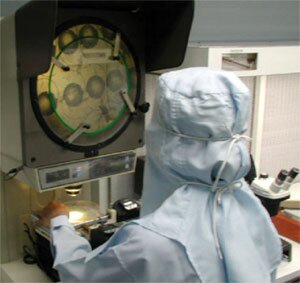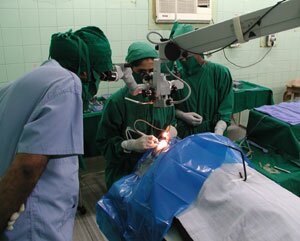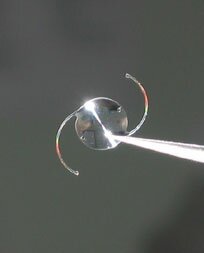|
 In August of 2002, Project Impact and Aurolab teamed up to develop a novel, affordable foldable intraocular lens for production at Aurolab in Madurai, India. The foldable product will complement Aurolab's existing product line of of high quality IOLs at globally affordable prices. Since teaming up with David Green (via Seva Foundation) in 1992, Aurolab has played a catalytic role in bringing down the prices of PMMA lenses from over $300 in the early nineties to under $10 per lens today. Aurolab currently produces over 600,000 PMMA IOLs annually, selling them to customers in 86 countries. One of their major customers is the Aravind Eye Care System which performs over 200,000 cataract surgeries annually via its 5 hospitals in Tamil Nadu, India . Now that surgical preferences are shifting toward hydrophobic acrylic materials, Aurolab and Project Impact continue the tradition of making leading edge ophthalmic technology globally affordable. In August of 2002, Project Impact and Aurolab teamed up to develop a novel, affordable foldable intraocular lens for production at Aurolab in Madurai, India. The foldable product will complement Aurolab's existing product line of of high quality IOLs at globally affordable prices. Since teaming up with David Green (via Seva Foundation) in 1992, Aurolab has played a catalytic role in bringing down the prices of PMMA lenses from over $300 in the early nineties to under $10 per lens today. Aurolab currently produces over 600,000 PMMA IOLs annually, selling them to customers in 86 countries. One of their major customers is the Aravind Eye Care System which performs over 200,000 cataract surgeries annually via its 5 hospitals in Tamil Nadu, India . Now that surgical preferences are shifting toward hydrophobic acrylic materials, Aurolab and Project Impact continue the tradition of making leading edge ophthalmic technology globally affordable.
Cataract, the loss of transparency of the natural crystalline lens of the eye, is a leading cause of blindness worldwide. The most effective treatment is the surgical replacement of the clouded crystalline lens with an artificial replacement known as an intraocular lens (IOL). Cataract surgery is the most common surgical procedure in the United States today; about half of Americans ages 65 to 74 have cataracts. In addition to age-related cataract, the condition can also be congenital, or develop as the result of injury. In the developing world, cataract blindness and poverty are often coincidental. The disability increases the risk of  poverty (as cataract blind are unable to earn a living wage), and conditions of poverty increase the probability of cataract blindness as poorer patients are often unaware of treatment options or unable to pay for them. Project Impact's Affordable Foldable IOL Project builds upon previous collaborations between David Green and Aurolab to make high quality, leading edge IOL technology globally affordable, with an emphasis on serving the world's poorest cataract blind. poverty (as cataract blind are unable to earn a living wage), and conditions of poverty increase the probability of cataract blindness as poorer patients are often unaware of treatment options or unable to pay for them. Project Impact's Affordable Foldable IOL Project builds upon previous collaborations between David Green and Aurolab to make high quality, leading edge IOL technology globally affordable, with an emphasis on serving the world's poorest cataract blind.
Depending on the experience of the surgeon and the complexity of the case, cataract surgery can take as little as 15 minutes to conduct, and post operative visual acuity can be 20/20, even if the patient's vision was worse than 20/20 to begin with. The low cost of surgery and extremely high rate of success make cataract surgery among the most cost effective public health interventions. An Aravind Eye Hospital study of Indian cataract patients found that 85% of males and 58% of females who lost their job as a result of cataract regained those jobs after cataract surgery. Many who did not return to work freed their family members from having to care for them, thereby enabling family members to work and generate revenue. Overall, the study concludes that recipients of cataract surgery enjoy an average increase in household income in the first post-operative year equivalent to 15 times the cost of surgery.
 Intraocular lenses, the most expensive consumable in cataract surgery, can be made either from foldable materials such as flexible acrylics and silicones, or from rigid materials like PMMA. Of the 1.4 million cataract surgeries performed in the United States in 2002, approximately 96% were done using foldable lenses. Many surgeons prefer the flexible materials because they are able to fold the implant in half and insert it into the eye through a smaller incision than a full size rigid lens. Smaller incision sizes have been correlated with a number of clinical advantages. Additionally some foldable lens designs and materials are associated with lower rates of posterior chamber opacification (PCO), one of the most common post-operative complications of cataract surgery. Of the flexible materials, hydrophobic acrylics are most commonly preferred with around half of the global foldable market. Intraocular lenses, the most expensive consumable in cataract surgery, can be made either from foldable materials such as flexible acrylics and silicones, or from rigid materials like PMMA. Of the 1.4 million cataract surgeries performed in the United States in 2002, approximately 96% were done using foldable lenses. Many surgeons prefer the flexible materials because they are able to fold the implant in half and insert it into the eye through a smaller incision than a full size rigid lens. Smaller incision sizes have been correlated with a number of clinical advantages. Additionally some foldable lens designs and materials are associated with lower rates of posterior chamber opacification (PCO), one of the most common post-operative complications of cataract surgery. Of the flexible materials, hydrophobic acrylics are most commonly preferred with around half of the global foldable market.
Hydrophobic acrylic foldable intraocular lenses are currently produced and sold by three major companies: Alcon, AMO, and Medennium. Each company uses a proprietary material, making material development the barrier to entry in the hydrophobic acrylic market. Alcon holds the largest marketshare, with around 50% of the US market. Their next competitor, AMO, has around 26% of the US Market. All three companies currently charge well over $100 per lens. While this price is well within the means of most American customers, it presents a substantial barrier to patients in the developing world, where the vast majority of the world's cataract blind reside.
|
